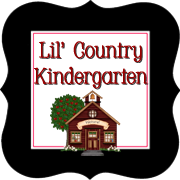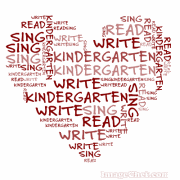Many days during guided reading, I find myself focusing more on writing than on reading with some of my groups. It is amazing how much writing will help move along many of the reading skills we are working on.
My lowest group, which is not quite ready for level A books, has been developing lots of great concepts of print through our daily interactive guided writing sessions. These writing lessons are nothing like our writing workshop time later in the day-this small group guided writing is focused on developing beginning reading and writing skills.
We have been working on writing our own little predictable books. I give them a blank book that just has pictures, and we write the text together.
Click here to download a copy of the book we worked on writing today-called My Animal Book (even though the pictures are in color, I just print it in black and white and let them color the pictures in with crayons if they want).
The whole group opens up to the same page in the little book (we usually just write one page a day). Today we opened up to a page that has a cow in the picture. We decided to write the sentence "I see a cow." I help them choose the sentence because I want it to be simple and include some sight words that they know. This particular group already knew the sight words "I" and "a" and we just learned the word "see" last week-so the sentence we were writing was perfect practice!
The first thing we do is practice saying the sentence several times-this way we don't forget it! I always ask them to practice whispering it too! Then we clap or tap each word so that we get practice hearing the word breaks in sentences. Each word gets just one clap-this is not about syllables! Then we practice counting how many words-we hold our fingers up as we count. Finally we are ready to begin writing.
The first question I ask them is to point on their paper to where we will start writing. I definitely want to reinforce that we start on the left side of the page. Then I ask them to say the sentence "I see a cow" and tell me which word comes first. They practice writing the word "I" in the air with their finger (I check to make sure they are making the capital letter). Then they get to write the first word on their paper.
Next, we point to the word we wrote and read it. I ask them what word comes next. They tell me it is the word "see". Since this word is one of our new sight words, I ask them to practice it a few times on their practice page (this is just the back of the previous page which is blank). When I see that they are writing it correctly, I let them point to where they think it should go in their sentence (if they haven't left a space, we talk about that).
Then we point and read our sentence so far and I ask them what word comes next. Since it is the word "a" and they all know how to write it, I don't make them use the practice page. We trace it once on the table with our finger, then they point to where they think it should go in their sentence. If they have pointed to the right spot (and left a space) I let them each write it in their book.

I then ask them to point to each word in their sentence and read it out loud so we can figure out what word comes next. The final word is "cow." Since this is not a word they know or a sight word, I am going to help them with this one. We work on saying the word slow together and hearing the first sound. I ask them to point to the letter on their alphabet chart that they hear at the beginning of cow. Some pointed to the "C" and some pointed to the "K" so I went ahead and told them that cow starts with "c" just like cat on their alphabet chart. Thankfully no one pointed to a letter that didn't make sense! Then they pointed on their paper where they thought the word should go. This was a great opportunity to talk about return sweep, since there was no more room on the first line and we had to start a second line to write the word cow.

To finish writing cow, I told them that an "o" was the next letter (I am not expecting them to be able to figure that out on their own at this point) and then they helped me figure out that there was a "w" sound at the end of the word and we wrote that. I asked them to point and read their page to see if their sentence was finished-they said all the words were there and thankfully one of my students reminded us to put the period at the end! Finally-after nearly 10 minutes we had written one whole sentence! It seriously takes a LOT of time-but it is SO worth it.
We were not done with our lesson though! I like to practice pointing and reading the sentence several times as a group and then I let them each show me individually. They like to use their pencils as pointers sometimes. Then we play little "games" with our sentence. Really I am just prompting them to demonstrate some concepts of print. I ask them a few questions like these:
- Point to the first word
- Point to the last word
- Point to where you start reading on this page. Where do you go next?
- Find a capital letter. Do you know what letter you found?
- Find a lowercase letter. Do you know what letter you found?
- Find the letter ____
- Find a space
- Find the period
- Find a word with 2 letters (or 3 letters, etc.)
- Find our sight word _____
- Find the word _______ (How do you know that is the word _____?)
- Find a word that begins with the letter _____
- Find a word that ends with the letter _____
- Point to the word _____. How many letter are in that word?
- Count how many words are in our sentence
- Count how many letters are in our sentence
- Count how many spaces are in our sentence
- Practice reading the sentence. Point under each word as you read it.
These little books make great writing practice-but also great reading practice. After we write them we use them as shared reading texts-and instead of looking at my big book or poetry chart like a usual shared reading session-each kid has their own little book to point to so everyone is engaged in the small group lesson!
We also sometimes do some quick word work after we write and read these little books. For example, since today we were using the word "see" in our book, we practiced building the word with magnetic letters. We did lots of "mix & fix" (mixing up the letters and then fixing them to make the word "see" again). We also practiced writing the word "see" on our dry erase boards, locating the word "see" in our book, and reading the page we found the word "see" on to get practice with the word in context.
Whew! This turned out to be a long post! I promise this was just a quick 20 minute small group lesson though-and it was with my most struggling group of kinders-they did a great job! I'd love to hear how your small group literacy lessons are going!



















































